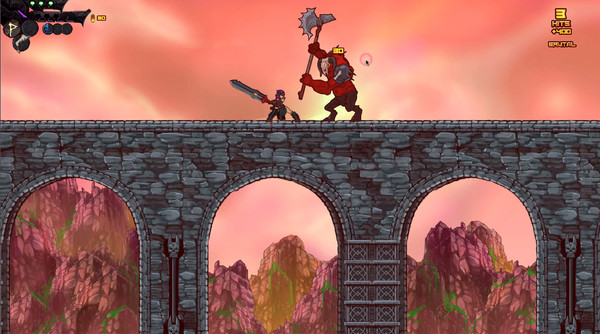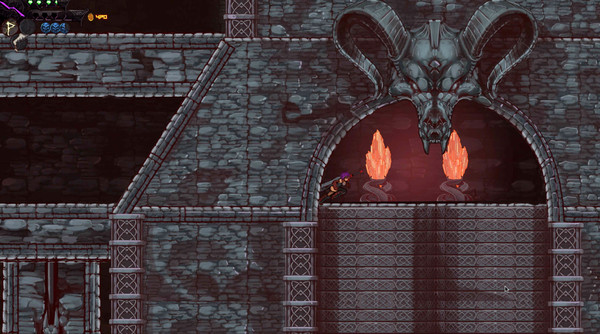- TDM Game Awards 2022 – Voting is now open! - December 6, 2022
- Dual Universe – PC Review - November 23, 2022
- Rogue Spirit – PC (P)review - July 19, 2022
Genre: Action, Adventure, Indie, Early Access
Developer: Demon Sword Games
Publisher: 378 Publishing Ltd
Release Date: Mar 30, 2017
Review by DarkLunarDude
Edited by KnightAvenger

With a market a rogue-like game has to work with, seeking individuality is a key element to separate you from your next big contender, whether it be by the art style, game play, or, even, theme. Thus, when a Norse-themed rogue-like comes out onto the scene, sporting Metroidvania-style combat, still in early access to boot, I had to check it out: Tyrfing Cycle. Tyrfing Cycle is an action, adventure rogue-like developed by Demon Sword Games, published by 378 Publishing Ltd, that, while in its early access state, has so much going for it but also so much hindering it from becoming the rogue-like to play.
Starting with the story, Tyrfing Cycle has a very small but simple premise that becomes something much bigger as you play on, for better or worse in some cases. We, the player, play as Hervor, a warrior who has taken up tyrfing, the sword of legend, as she seeks to find her father by traveling among three different worlds of the game. However, it quickly becomes more than this, as a plot is uncovered that someone is seeking to take over the Norse gods. Now, with tyrfing at her back and the will of a warrior at her side, Hervor must hunt down the demons who stand in her path to get the answers she seeks.

This type of story leaves not much room to change your fate but it does keep itself whole, which I can appreciate here, as the tale suffers from being so wide open at the start. As a reviewer, I appreciate open stories that allow it to give the player a sense of accomplishment when you slay that thing that has been in your path. However, when the story throws you head first into a level with almost no backstory, it feels empty and pointless, in a better sense, to go forward on your journey.
The next major area to speak of is combat and mechanics, an area I found Tyrfing Cycle excels at, with some major game play issues being the biggest hold back for this title. Let us start with combat, which I felt was refreshing and clean but still smooth and well animated. Combat consists of tyrfing, your sword, and the various side weapons, alongside the various types of magic you can use. Tyrfing is your bread and butter for combat, being quick, agile and smooth to play with, as the impact was felt when you go into that brief one to two second motion of being unable to move. It had weight to it and felt like they aimed for realism instead of allowing it to get out of hand quickly. The only other major weapon element to the game is the various side weapons you can acquire as you play through each level. These side weapons, while good and useful in many instances, were more for flair, as it felt like the damage they did in comparison to tyrfing was near nothing. They do serve a better purpose, though, which I will explain in the magic section of combat.

Bring out your magic staff as we delve into the magic system of Tyrfing Cycle, which, at its core, can be one of your greatest tools or weaknesses, if not played properly. Magic is found in the form of various elements, such as poison or lightning, but what separates magic in Tyrfing Cycle from other games is how you use it. Magic is dropped in various locations like short burst spells in which each has a different effect and can be placed where you aim it at. These spells are limited range, though, so positioning is very important for certain fights to make sure you get the best of the damage possible at the time. There is one way to make magic more effective, though: the use of side weapons. You see, the side weapons have one of the coolest effects in the game, where, if the magic element you are using is aligned with the side weapon you are using, you can amplify the effect of that spell by casting it nearby or on the weapon itself. This makes some boss fights and enemies easier to play around with, where they would be usually tougher, because you have just enough damage from that weapon to make swing tyrfing more rewarding.

However, the combat system has a dark side and it can be a tough one to get past. The biggest issue I personally ran into is that I like playing with controllers on rogue-like games. Usually, this is not an issue, as the game has made that feature more accessible, but Tyrfing Cycle has some very unforgiving input controls currently in early access. Many times, the left stick for movement wouldn’t go forward or back when you load into a room unless you do a charge attack, while, other times, it goes left and right with ease to the point where you end up going past the enemy you were trying to hit and take damage. The jump feature is also pretty unforgiving for both X input and keyboard, as it is controlled, by default, by the W key or up arrow. This makes some enemies, like bosses, very unforgiving if you cannot get into a pattern of jumping and swinging on the fly, as your side weapons and magic, while strong together, still lack some oomph early on. If Demon Blade Games keeps up the work on this X input system, maybe find a better place for the jumping controls, I can really see this as not a big issue and a big bonus for the game, as the rest of the controls are smooth and very fluid to play with.

Now let us talk about boss battles, one of the hardest but most enjoyable combat experiences I can say Tyrfing Cycle brings to the table. The boss battles themselves are considered good, as they are quite the challenge to new players, as learning when to dodge left or right of an attack versus when to jump up onto a platform and smack away is vital. It is also here I find using the combination of magic and side weapon is at its strongest, as these elements can be strong or weak again one boss but not another, making it a challenge to remember what works and what does not. Each boss is also unique in how they look and attack based on what part of Norse mythology they come from, an interesting design choice, as it brings a unique flavor to the table.

Entering into the field of visuals and graphics, Tyrfing Cycle is broken down into stage levels based on three different land types: undead, giants and dark elves. Each of these lands has its own unique features and creatures specific to them while sharing this theme of heavy metal amongst the three, so, no matter where you go, you can always rock on. The backgrounds are one of my favorite details visually for the game, offering a dark and rich background to jump, slash and murder your enemies in but keeping with the Nordic, heavy metal inspired feeling with various types of skulls and architecture that flow between the three world types.

Let us not forget the metal-inspired soundtrack to fill this dark and grim world Tyrfing Cycle presents to us. The heavy metal-based soundtrack that accompanies this game is very inspired by Nordic legends, which shows very heavily in the boss battle music, and the music can go from silent to head banging in seconds. The riffs from the guitar and drums, alongside some more traditional instruments, are the perfect note to slice through the world to, as it fits in as both background music and as this area to just pump you up to fight more enemies.
Pros:
- Simple but interesting story premise
- Solid combat mechanics between the weapons and magic system
- Intense and challenging boss battles
- Dark and grim visual style with the focus on three types of worlds
- The nordic metal-inspired soundtrack is headbang worthy
- Some of the smoothest controls in a while for a rogue-like
Cons:
- Story felt too open ended in the beginning
- The X-input system is too random, sometimes working and other times, not
- The jump button mapping was oddly placed for the game’s combat style
- Some visual places can be too dark at times
My final thoughts on Tyrfing Cycle in early access are as such. Overall, I found the game to be a great Metroidvania-inspired rogue-like set into this gothic Nordic setting with a story that can be considered forgettable in some ways but, otherwise, sits with you and tries to draw you into the demonic world. The game play it offers is some of the smoothest I have seen for rogue-likes in a while, being quick and responsive to commands but having the weight of the weapons feels on point to a real life weapon. The X input is unreliable, to say the very least, in its current state of early access, but I feel that if the developer keeps working on it as they have been, this could easily be one null factor. The visuals and music, as well, are something I enjoyed, giving us a new sense of direction, as the art and soundtrack focus heavily on a Nordic-style setup while not oversaturated with the metal elements utilized by the game’s assets. Would I recommend Tyrfing Cycle in its current early access state? Yes, but I will give my warning for those who are controller users to, maybe, hold off on this one, as even at the price of $4.99 on Steam to get early access, the controller support is shaky at best but is constantly being worked on, so definitely a pickup for the future.






